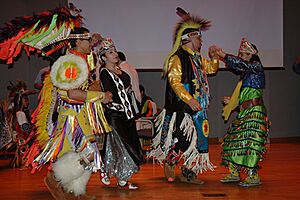Haliwa-Saponi Indian Tribe facts for kids

Official seal of the
Haliwa-Saponi Indian Tribe |
|
| Named after | Halifax, Warren, and Saponi people |
|---|---|
| Formation | 1953 |
| Type | state-recognized tribe, nonprofit organization |
| Legal status | social advocacy organization; ethnic center; arts, culture, and humanities nonprofit, charity |
| Purpose | A23: Cultural, Ethnic Awareness |
| Location | |
|
Membership
|
4,300 |
|
Official language
|
English |
|
Executive Director, Tribal Administrator
|
Kathy Harris, Interim Tribal Administrator |
|
Revenue (2020)
|
$3,111,855 |
| Expenses (2020) | $2,915,7762 |
|
Staff (2020)
|
105 |
The Haliwa-Saponi Indian Tribe is a Native American tribe recognized by the state of North Carolina. This means the state officially acknowledges them as an Indigenous group. They are not yet recognized by the United States federal government. The tribe's main office is in Hollister, North Carolina.
The Haliwa-Saponi Tribe formed its current government in 1953. North Carolina officially recognized them in 1965. Before this, they were known as the Haliwarnash Indian Club. The tribe has worked hard to create schools and other places to keep their culture and identity strong. Most tribal members are Protestant Christians, often Baptist or Methodist.
About the Haliwa-Saponi Tribe
What's in a Name?
The name Haliwa comes from two counties in North Carolina: Halifax and Warren. It's like blending two words together! In 1979, the tribe added Saponi to their name. This was to honor their ancestors, the historical Saponi people. The Saponi were part of a larger group that spoke Siouan languages. They lived in the Piedmont region of what is now Virginia and the Carolinas.
Who are the Haliwa-Saponi?
Today, the Haliwa-Saponi Tribe has over 3,800 members. Most of them, about 80%, live close to the town of Hollister. This area is mainly in Halifax and Warren counties. Other tribal members live in nearby Nash and Franklin counties.
How the Tribe is Governed
The Haliwa-Saponi Indian Tribe is led by an 11-member council. Tribal members elect these leaders for three-year terms. The council includes an elected chief and a vice-chief. The tribe's main office is in Hollister, at the Chief W.R. Richardson Tribal Government Complex.
Official Recognition
North Carolina officially recognized the Haliwa-Saponi Tribe in 1965. In 1997, the state passed a law to update this recognition. This confirmed their status as a state-recognized tribe.
The Haliwa-Saponi Tribe is not yet recognized by the United States federal government. Federal recognition means the tribe would have a special relationship with the U.S. government. In 2022, Representative G. K. Butterfield supported federal recognition for the tribe. In April 2025, Representative Don Davis introduced a bill, H.R. 2929, to grant federal recognition. This news was shared during the tribe's 60th annual powwow.
Learning and Culture
In 1957, tribal members started the Haliwa-Saponi Tribal School. At that time, public schools were separated by race. The Haliwa-Saponi wanted their own school to maintain their unique identity. This school closed in the late 1960s when schools across the country became integrated.
In 1999, the tribe opened a new charter school in the same building. This school focuses on Haliwa-Saponi culture. It has grown over the years and by 2007, it taught students from kindergarten to 12th grade. The tribe also opened the Haliwa-Saponi Day Care Center in 1977 for young children. They offer many programs for their members. These include housing help, cultural activities, and other community services.
A Look at Haliwa-Saponi History
Early Beginnings
The Haliwa-Saponi people trace their roots to the Tuscarora, Nansemond, and Saponi tribes. These were Native American groups from the southeastern United States. In the early 1700s, the Saponi faced many challenges. They experienced conflicts with other groups and illnesses from Europeans.
The Saponi joined with other tribes and moved closer to Virginia's colonial trade centers. They became allies with the colonists. In 1711, the Carolina colony had conflicts with the Tuscarora people. After the Tuscarora were defeated, many moved north to New York. The Saponi made a new trade agreement with Virginia's governor.
In 1714, several smaller tribes, including the Saponi, came together. They formed "The Saponi Nation." Even with this new unity, they faced difficulties. Their population continued to decline due to illness. The Virginia Council asked the Nansemond tribe to join them. They hoped these combined groups could protect Virginia's settlements.
Fort Christanna and New Settlements
To strengthen Virginia's borders, Governor Alexander Spotswood helped create Fort Christanna. This fort was built to protect the colony. It also served as a place to educate and convert Saponi children to Christianity. About 70 Saponi children learned at Fort Christanna. The fort was also a major trading post.
By 1717, the trading company at the fort closed. The Saponi Nation continued peaceful trade. Some Saponi stayed near Fort Christanna. Others moved north into Virginia.
During the 1730s, the Haliwa-Saponi ancestors began to form their community. This was a time of change for Native American trade. Some Saponi moved south to live with the Catawba tribe. Later, they returned to the Fort Christanna area. They found that colonists had claimed their traditional lands.
The Saponi made agreements for new lands with Virginia. They also agreed to live with the remaining Tuscarora in North Carolina. Most Saponi moved to North Carolina with traders and planters. They settled in what are now Halifax and Warren counties.
Building a Community
From the 1730s through the American Revolution, Saponi people married European colonists and free people of color. Saponi mothers raised their children in Saponi culture. After the Revolution, Native Americans kept their distinct identity. They mostly married within their own community. They also created groups to support their American Indian culture.
Haliwa-Saponi ancestors settled in the modern Haliwa-Saponi area after the American Revolution. By the 1800s, some Haliwa-Saponi families moved to Ohio.
Throughout the 1800s, the Haliwa-Saponi maintained a close-knit community. They lived in Halifax, Warren, Nash, and Franklin counties. They mostly married within their tribe. They became Christian and established churches, like Jeremiah Methodist Church.
After the American Civil War, public schools were created but were separated by race. Haliwa-Saponi children were often sent to schools with African American children. After 1877, the Haliwa fought for separate Indian schools. They also began to organize their tribal government more formally.
With the rise of "Jim Crow" laws, which separated people by race, the Haliwa-Saponi faced challenges. These laws also made it harder for them to vote. Despite this, the Haliwa continued to build their own cultural institutions. They gained state approval for Indian schools, like Bethlehem School in 1882.
Modern Times and Reorganization
In the early 1900s, more African American workers moved into the area. This led to some Haliwa wanting separate worship spaces. They started St. Paul's Baptist Church, which was an all-Indian congregation until the 1950s.
Later in the 20th century, local Indian schools closed. Tribal leaders worked to have members' birth certificates show their American Indian ethnicity. However, the state often only classified people as "black" or "white."
In the 1940s, they organized as the Haliwarnash Indian Club. This name was later shortened to Haliwa Indian Club. In 1979, they added "Saponi" to their name to honor their history. In 1956, the Haliwa-Saponi joined the National Congress of American Indians.
In 1953, the tribe reorganized its government into its current structure. Leaders like John C. Hedgepeth and Chief Jerry Richardson guided this effort. After the U.S. Supreme Court ruled against school segregation in 1954, North Carolina allowed private schools. The Haliwa-Saponi used this to open the private Haliwa Indian School in 1957. It was only for Indian children and operated until 1969.
In 1957, the Haliwa Indian Tribe built the Saponi Indian Church. It is now called Mt. Bethel Indian Baptist Church. In 1965, North Carolina formally recognized the Haliwa Indian Tribe. In 1967, the Haliwa opened their annual powwow to the public. This invited state officials and other Native Americans.
In 1974, the Haliwa-Saponi created a 501(c)(3) nonprofit organization. Its goal is to protect the interests and culture of the Haliwa-Saponi people. The tribe has built new buildings and started many programs. These include housing, daycare, and cultural programs.
In 2000, the Haliwa-Saponi opened the Haliwa-Saponi Tribal School. This public charter school teaches the state curriculum. It also offers small classes and American Indian studies. In 2020, the school had 161 students.
Haliwa-Saponi Today
Celebrating Culture: Powwows and Programs
The Haliwa-Saponi Tribe hosts an annual powwow. It takes place on the third weekend in April at the tribal school's dance grounds. They started this powwow in 1965 to celebrate their state recognition. The powwow is a vibrant celebration of Native American culture. It includes dancing, drumming, and community gathering.
The tribe also has a cultural program for all ages. It is held at their multi-purpose building. This program teaches pottery, beadwork, dance, and tribal history. They also take day trips to important cultural sites.
Famous Haliwa-Saponi People
- Brooke Simpson, a talented singer from The Voice
- Sky Lakota-Lynch, a Tony Award-nominated actor


